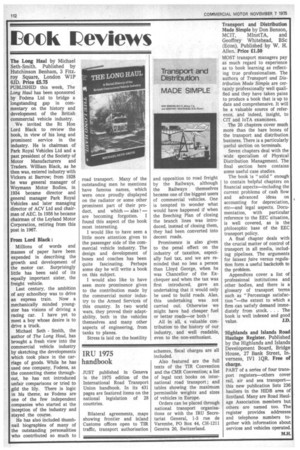113ock IQeviews
Page 114

If you've noticed an error in this article please click here to report it so we can fix it.
The Long Haul by Michael Seth-Smith. Published by Hutchinson Benham, 3 Fitzroy Square, London WIP 6JD. Price £5.75 PUBLISHED this week, The Long Haul has been sponsored by Fodens Ltd to bridge a longstanding gap in commentary on the history and development of the British commercial vehicle industry.
We invited the Rt Hon Lord Black to review the book, in view of his long and prominent service in the industry. He is chairman of Park Royal Vehicles Ltd and a past president of the Society of Motor Manufacturers and Traders. William Black, as he then was, entered industry with Vickers at Barrow; from 1928 he was general manager of Weymann Motor Bodies, in 1934 became director and general manager Park Royal Vehicles and later managing director of ACV Ltd and chairman of AEC. In 1958 he became chairman of the Leyland Motor Corporation, retiring from this post in 1967.
From Lord Black :
Millions of words and masses of paper have been expended in describing the growth and development of the motor car. Surprisingly little has been said of its equally important sister, the freight vehicle.
Last century, the ambition of any schoolboy was to drive an express train. Now a mechanically minded youngster has visions of driving a racing car. I have yet to meet a bay whose desire is to drive a truck.
Michael Seth Smith, the author of The Long Haul, has brought a fresh view into the commercial vehicle industry by sketching the developments which took place in the carriage of goods. While he has used one company, Fodens, as the connecting theme throughout, he has not introduced unfair comparisons or tried to gild the lily. There is logic in his theme, as Fodens are one of the few independent companies who started at the inception of the industry and stayed the course.
He has also included thumbnail biographies of many of the outstanding personalities who contributed so much to road transport. Many of the outstanding men he mentions have famous names, which were once proudly displayed on the radiator or some other prominent part of their product, and which — alas ! — are becoming forgotten. I found this aspect of the book most interesting.
I would like to have seen a little more attention given to the passenger side of the commercial vehicle industry. The design and development of buses and coaches has been quite fascinating. Perhaps some day he will write a book on this subject.
I would also like to have seen more prominence given to the contribution made by the commercial motor industry to the Armed Service S of this country. In two world wars, they proved their adaptability, both in the vehicles themselves and many other aspects of engineering, from tanks to planes.
Stress is laid on the hostility and opposition to road freight by the Railways, although the Railways themselves became one of the biggest users of commercial vehicles. One is tempted to wonder what would have happened if when the Beeching Plan of closing the branch lines was introduced, instead of closing them, they had been converted into decent roads.
Prominence is also given to the penal effect on the industry of taxation, especially fuel tax, and we are reminded that no less a person than Lloyd George, when he was Chancellor of the Exchequer and when the tax was first introduced, gave an undertaking that it would only be used to build roads. Alas, this undertaking was not carried out. Otherwise we might have had cheaper fuel or better roads—or both !
All in all, a valuable contribution to the history of our industry, and well readable, even to the non-enthusiast.
















































































































































































































